GS Instech SMT-I33 In-Building RF Repeater User Manual
GS Instruments Co., Ltd. In-Building RF Repeater
User Manual
Smart-Cell Repeater
User Manual
33 dBm
Febuary, 2015
Version 1.1

Verizon User Manual
Smart-Cell Repeater
2
- INDEX -
1. INTRODUCTION .......................................................................................................................... 4
1.1. Warning .................................................................................................................................................................................... 4
1.1.1 FCC Warning Statements ....................................................................................................................................... 4
1.2. GST Smart-Cell Repeater Advantages ........................................................................................................................ 5
1.3. Repeater Operation ............................................................................................................................................................ 5
1.4. Abbreviation ........................................................................................................................................................................... 7
2. SYSTEM CONFIGURATION ........................................................................................................ 8
2.1. Smart-Cell Repeater Service Network Configuration ......................................................................................... 8
2.2. System Design and Operation ...................................................................................................................................... 9
2.2.1. System Design ............................................................................................................................................................ 9
2.2.2. Downlink/ Uplink Path ..........................................................................................................................................10
2.2.3. 700MHz Frequency Selection ............................................................................................................................11
2.2.4. 800MHz Frequency Selection ............................................................................................................................11
2.2.5. 850MHz Frequency Selection ............................................................................................................................12
2.2.6. 1900MHz Frequency Selection ..........................................................................................................................12
2.2.7. 2100MHz Frequency Selection ..........................................................................................................................13
3. SYSTEM SPECIFICATIONS ........................................................................................................ 14
3.1. RF Performance ..................................................................................................................................................................14
3.2. System Specifications.......................................................................................................................................................15
3.3. Electrical and Environmental Specifications ..........................................................................................................16
3.4. Functions ...............................................................................................................................................................................16
4. SETUP .......................................................................................................................................... 18
4.1. Equipment Needed for Repeater Setup .................................................................................................................18
4.1.1. Check points before turning on the Repeater ..........................................................................................18
4.1.2. Open for Service ......................................................................................................................................................19
4.1.3. Signal Strength LED Check .................................................................................................................................20
4.2. Setting up the Repeater .................................................................................................................................................21

Verizon User Manual
Smart-Cell Repeater
3
4.2.1. Quick GUI/Configuration .....................................................................................................................................21
4.2.2. Quick Setup ................................................................................................................................................................21
4.3. Web UI Ranges Table.......................................................................................................................................................22
4.4. Troubleshooting..................................................................................................................................................................23
4.4.1. Simple Troubleshooting Method .....................................................................................................................23
4.4.2. Alarm Information ...................................................................................................................................................23
4.4.3. Troubleshooting Guide Related to RF............................................................................................................27
4.4.4. Troubleshooting Guide Related to NMS ......................................................................................................30

Verizon User Manual
Smart-Cell Repeater
4
1. INTRODUCTION
Smart-Cell is a repeater, which has been designed to improve signals in blanket/shadow
areas inside of buildings to transmit Verizon’s signals at 700MHz, 850MHz, 1900MHz, and
2100MHz frequencies. User may choose filtering configuration according to the specific
site circumstances.
1.1. Warning
1.1.1 FCC Warning Statements
1) FCC Part 15.19 :
This device complies with Part 15 of the FCC Rules. Operation is subject to the
following two conditions:
(1) This device may not cause harmful interference, and
(2) This device must accept any interference received, including interference that
may cause undesired operation.
2) FCC Part 15.105 :
This equipment has been tested and found to comply with the limits for a Class B
digital device, pursuant to part 15 of the FCC Rules.
These limits are designed to provide reasonable protection against harmful
interference in a residential installation. This equipment generates, uses and can
radiate radio frequency energy and, if not installed and used in accordance with the
instructions, may cause harmful interference to radio communications. However,
there is no guarantee that interference will not occur in a particular installation. If
this equipment does cause harmful interference to radio or television reception,
which can be determined by turning the equipment off and on, the user is
encouraged to try to correct the interference by one or more of the following
measures:
- Reorient or relocate the receiving antenna.
- Increase the separation between the equipment and receiver.
- Connect the equipment into an outlet on a circuit different from that to which the

Verizon User Manual
Smart-Cell Repeater
5
receiver is connected.
- Consult the dealer or an experienced radio/TV technician for help.
3) FCC Part 15.21 :
Any changes or modifications not expressly approved by the party responsible for
compliance could void the user's authority to operate this equipment.
4) RF Exposure :
This equipment is not enclosing antenna and not demand specific vendor of
antennas. Use an antenna as operator’s guidance. But, the antennas must be
installed such that a minimum separation distance of at least 130cm is maintained
between the radiator (antenna) and all persons at all times. This device must not be
co-located or operating in conjunction with any other antenna or transmitter.
1.2. GST Smart-Cell Repeater Advantages
It provides selectable RF power levels for any wireless technology / band.
It has individual monitoring multiple technology.
FPGA digital filtering provides optimized RF performance.
It allows modification of technology via customer interface.
It is easily installed.
Frequency is easy to add / delete / change.
It has scalable single and multi-service design.
Customer data service is improved by adding 4G (LTE ).
It meets all Verizon’s technology requirements.
It guarantees 5 year warranty for all individual components.
Its modular design is a customer friendly and efficient.
1.3. Repeater Operation
Simple replacing of the amplifier unit allows to change service. Smart-Cell repeater
provides services at 700MHz, 800MHz, 850MHz, 1900MHz, and 2100MHz. One PSU
supplies electricity to maximum 4 amplifier units
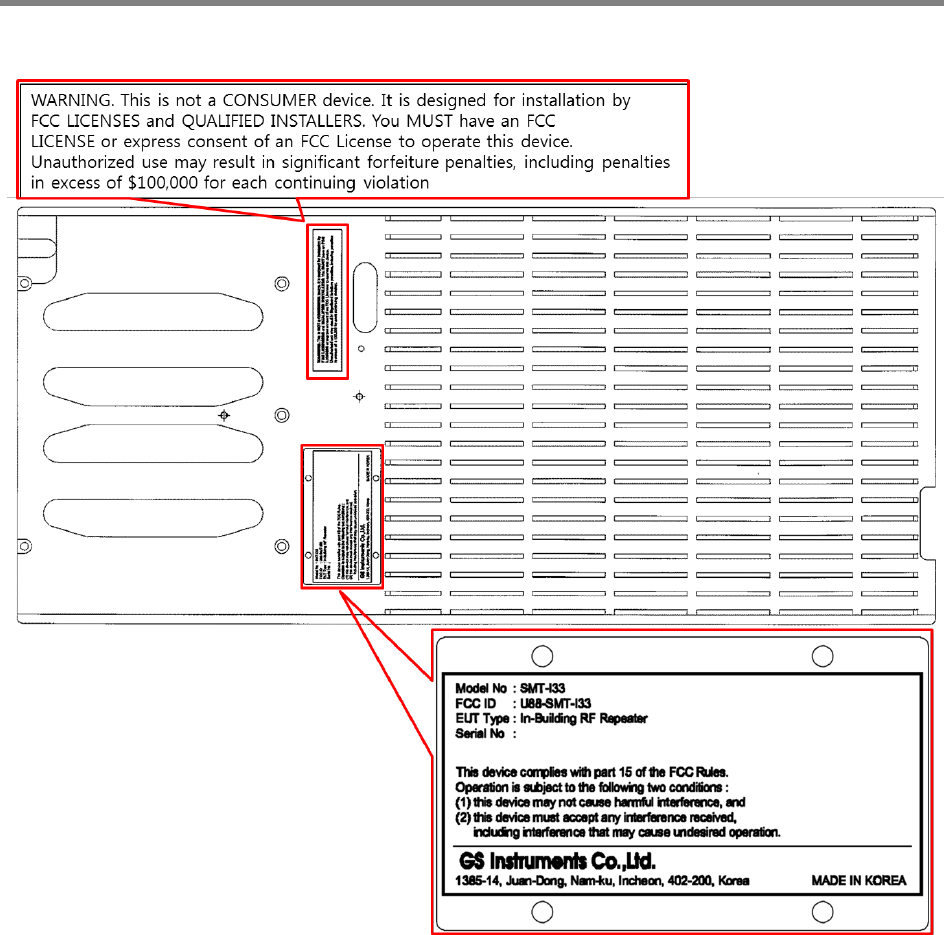
Verizon User Manual
Smart-Cell Repeater
6
2.1. Certification panel & Warning Label
Figure 1. Panel & Label
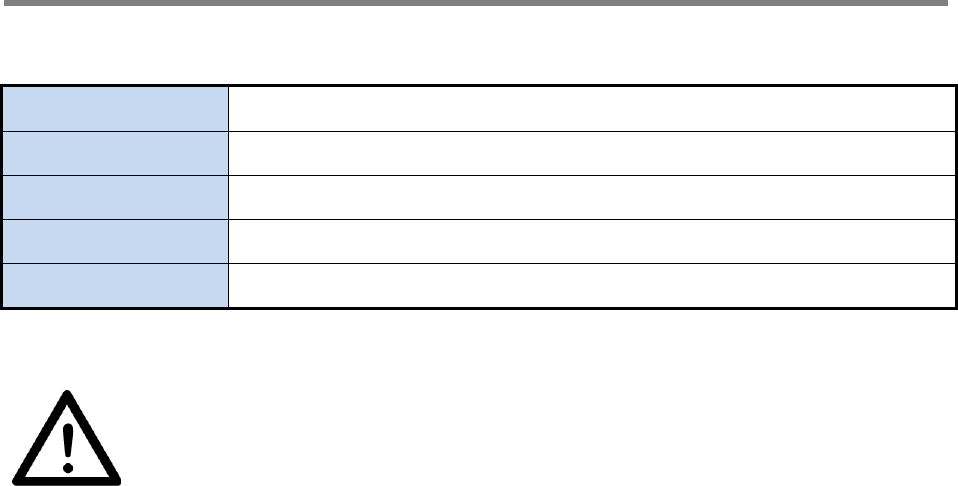
Verizon User Manual
Smart-Cell Repeater
7
1.4. Abbreviation
DFM
Digital Filter Module
PSU
Power Supply Unit
ALC
Auto Level Control
SNMP
Simple Network Management Protocol
AOC
Auto Oscillation Check
Caution: Risk of explosion if battery on the controller board is replaced by an
incorrect type.
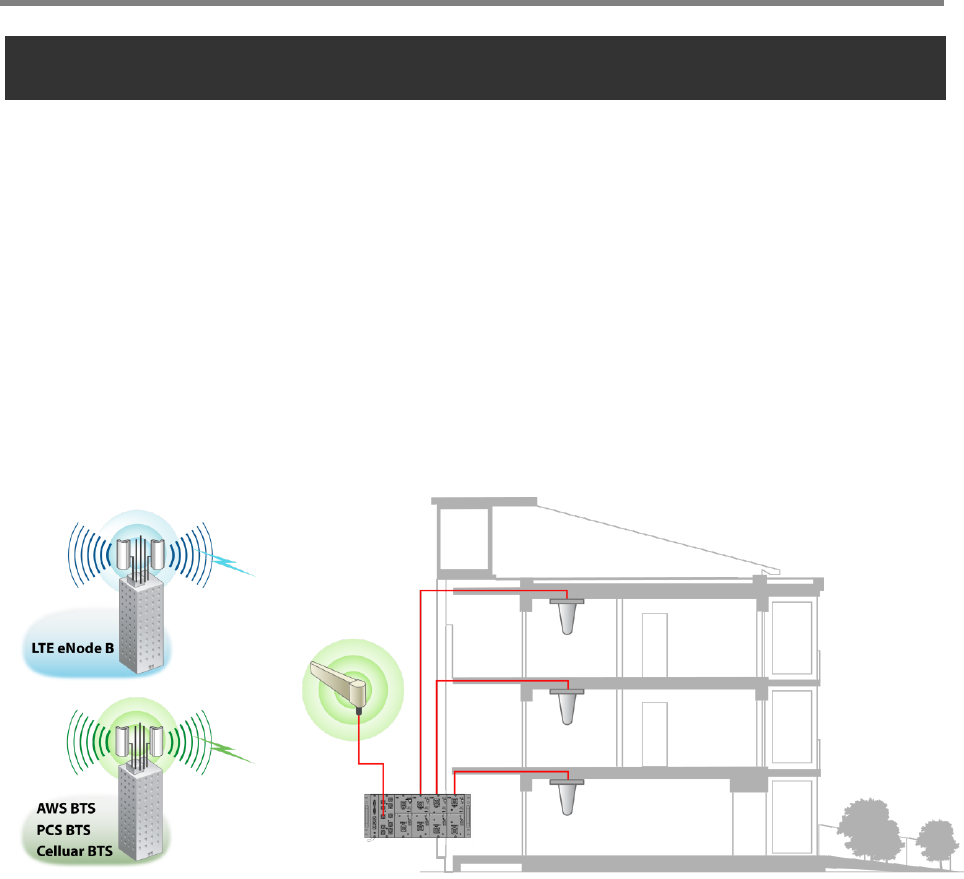
Verizon User Manual
Smart-Cell Repeater
8
2. SYSTEM CONFIGURATION
2.2. Smart-Cell Repeater Service Network Configuration
Smart-Cell RF Repeater is designed for improving coverage and capacity of Verizon’s LTE
& CDMA services nationwide. The repeater can provide coverage for all troubled areas
such as suburban, shadow areas, backside of mountains, urban and metropolitan
locations.
GST products are easy to install, have remote status monitoring and control functions
(NMS System) via wired line and wireless modems.
<Figure 1> In-building Repeater Service Organization
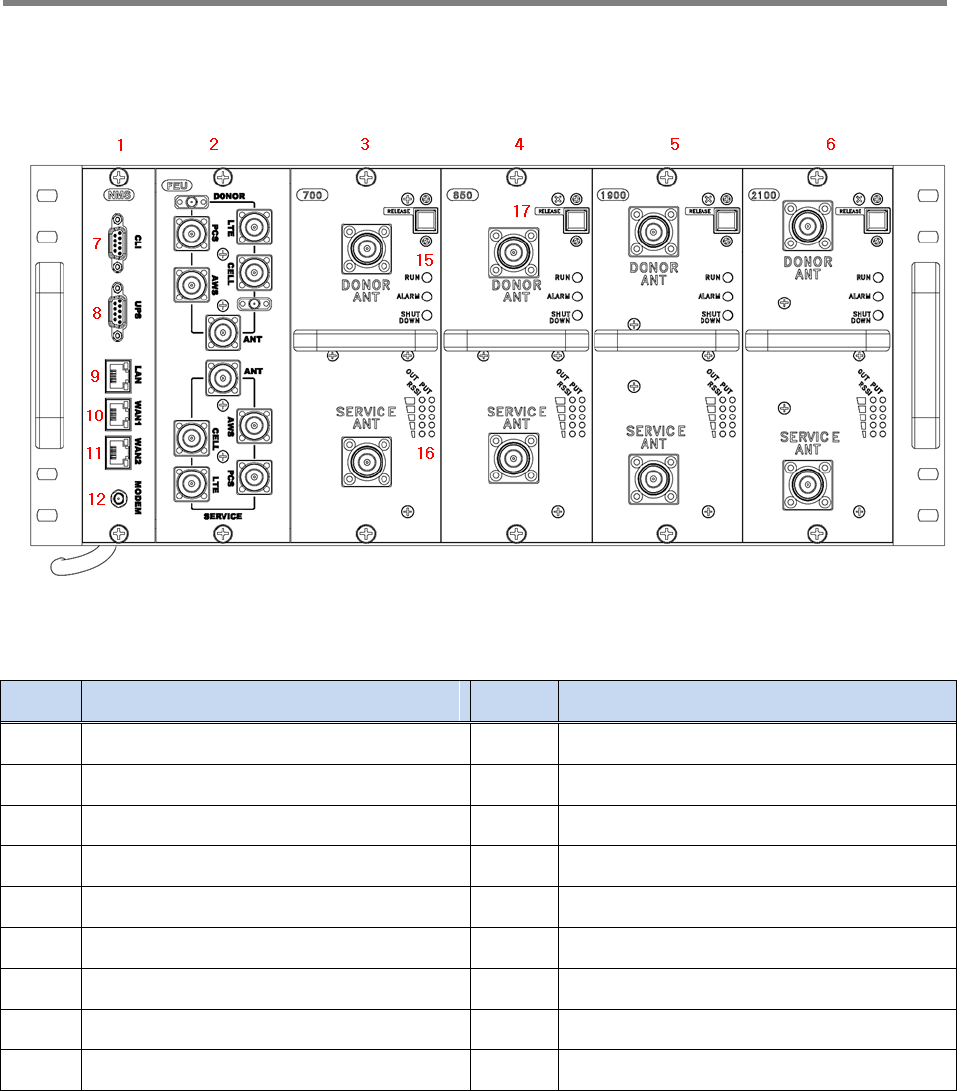
Verizon User Manual
Smart-Cell Repeater
9
2.3. System Design and Operation
2.3.1. System Design
<Figure 2> Smart-Cell Repeater Front Design
NO.
PART
NO.
PART
1
SNMP
10
WAN 1
2
FEU (Cavity Filter) , optional
11
WAN 2
3
Service Unit #1
12
Modem Connector
4
Service Unit #2
13
Donor Port
5
Service Unit #3
14
Coverage Port
6
Service Unit #4
15
Status LED (RUN/Alarm/Shutdown)
7
CLI
16
Input / Output LED
8
UPS
17
Release Button
9
LAN
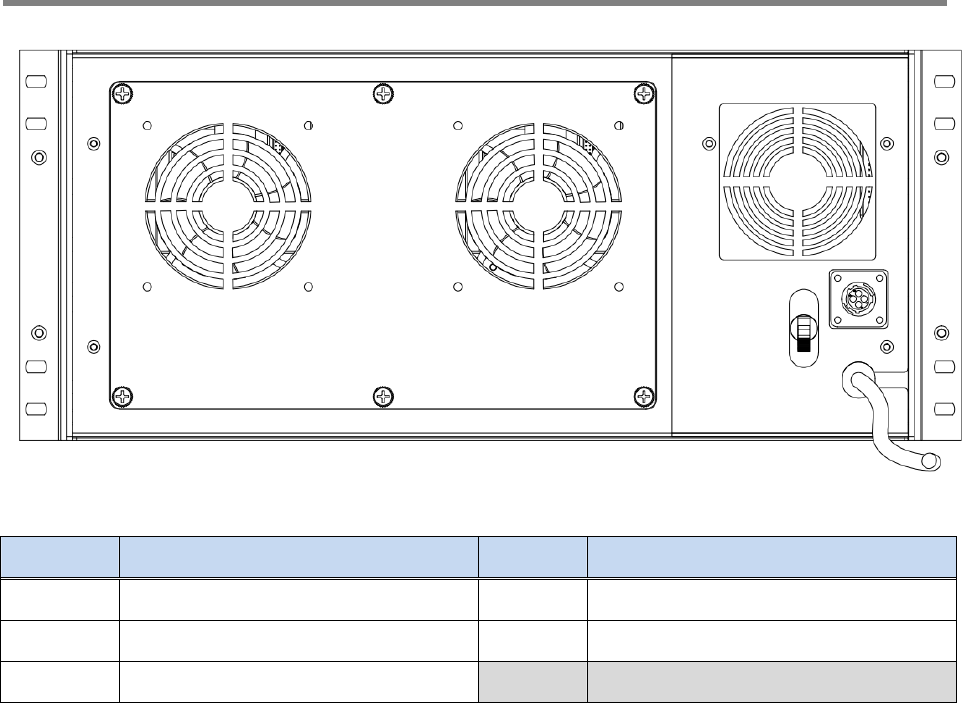
Verizon User Manual
Smart-Cell Repeater
10
<Figure 3> Repeater Port Design (Rear View)
NO.
PORT
NO.
PORT
1
Main FAN
4
DC 12V output (for EMB)
2
PSU FAN
5
Power Cable
3
Main Switch
2.3.2. Downlink/ Uplink Path
The Smart-Cell repeater improves service in the 700MHz, 800MHz, 850MHz, 1900MHz
and 2100MHz frequency bands. User may select frequency band according to the site
peculiarities. After receiving a weak signal from donor antenna, the repeater improves
and sends securely isolated signal out to service antenna.
Amplifier unit is designed for correspondent operation with digital filter module (DFM).
The AMP unit consists of a down and up converters, cavity filter and power amplifier
(PAU).
In Downlink Path, a weak RF signal is received from Donor Antenna. Being converted
from RF to IF signal, it is transferred to the DFM, where after digitalizing by DA
converter, signal is filtered by FPGA. After filtering digital, signal is converted into
analog RF signal with modulator. Transmit to amplifier. Desirable signal is amplified and
outputted through Service Antenna. Uplink path works vice versa.
1
2
3
5
4
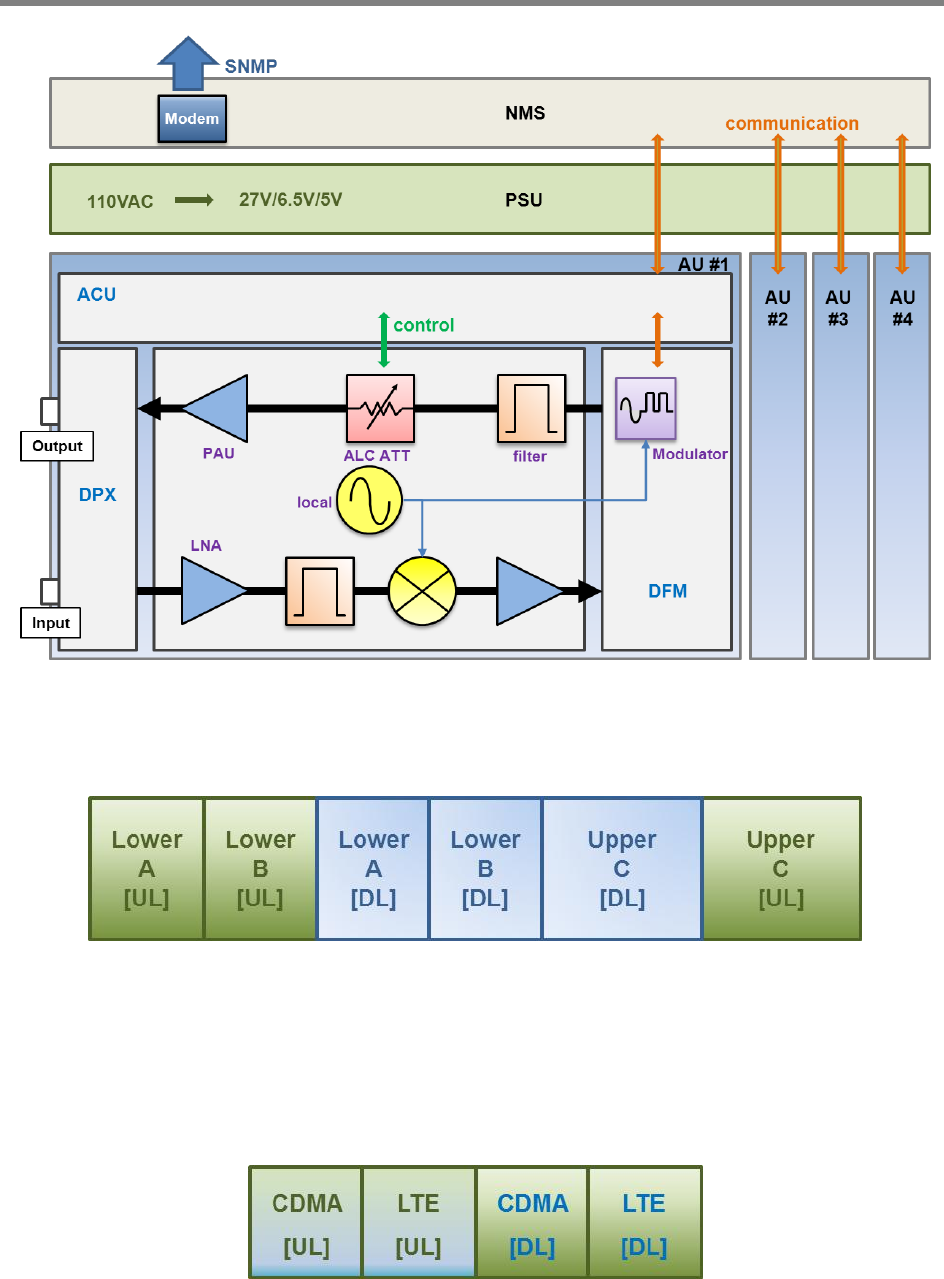
Verizon User Manual
Smart-Cell Repeater
11
<Figure 4> Smart-Cell Repeater Block Diagram
2.3.3. 700MHz Frequency Selection
<Figure 5> Smart-Cell Repeater 700 Block Diagram
700MHz Amp Unit provides a service that meets the 3GPP2 LTE standard. Support up to
two non-contiguous blocks. And each block has the minimum 5MHz bandwidth.
2.3.4. 800MHz Frequency Selection
<Figure 6> Smart-Cell Repeater 800 Block Diagram
800MHz Amp Unit has service Cellular 1FA and provides LTE 5MHz (25RB) by default.
ADC
DFM
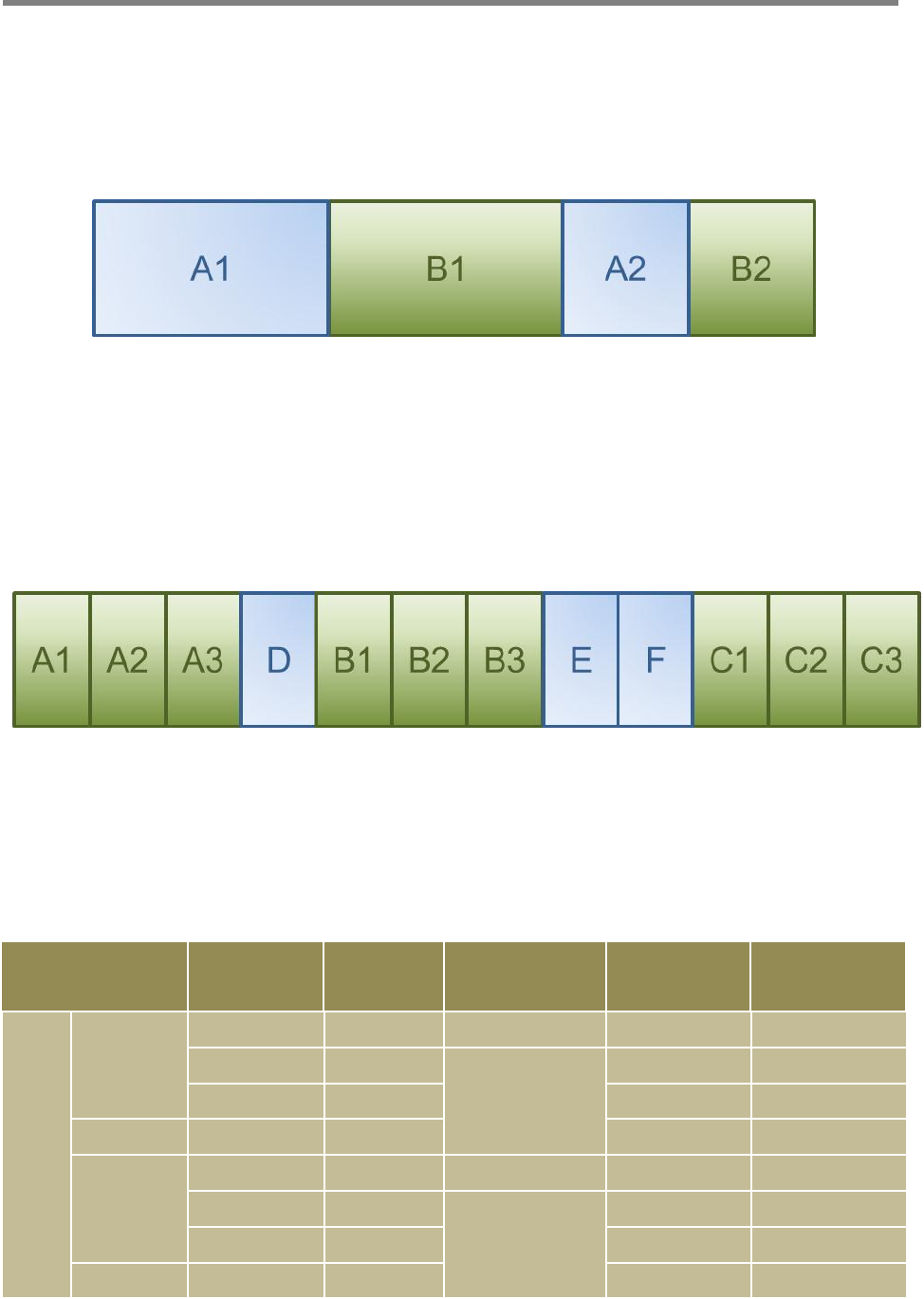
Verizon User Manual
Smart-Cell Repeater
12
On / Off control of the service Block is possible. Each block‘s bandwidth are as follows.
(CDMA[UL] – 1.25MHz, LTE[UL] – 4.505MHz, CDMA[DL] – 1.25MHz, LTE[DL] – 4.505MHz)
2.3.5. 850MHz Frequency Selection
<Figure 7> Smart-Cell Repeater 850 Block Diagram
850MHz Cellular service provides by default, and supports up to two non-contiguous
blocks. Each block‘s bandwidth are as follows, and it is possible to choose any
combination of any band. (A1 - 11MHz, B1 - 10MHz, A2 - 1.5MHz, B2 - 2.5MHz.)
2.3.6. 1900MHz Frequency Selection
<Figure 8> 1900MHz Band Frequency
1900MHz AMP Unit is basically complied with PCS Band block, where maximum three
non-contiguous filtering configurations are available. Each sub block is adjustable per
1.25MHz bandwidth step up to 20MHz. Following table shows user selectable channel
numbers.
BAND
DL CENTER
[MHz]
CHANNEL
BAND
DL CENTER
[MHz]
CHANNEL
A
A1
1931.25
25
guard
1965
700
1932.5
50
E
1966.25
725
1933.75
75
1967.5
750
guard
1935
100
1968.75
775
A2
1936.25
125
guard
1970
800
1937.5
150
F
1971.25
825
1938.75
175
1972.5
850
guard
1940
200
1973.75
875
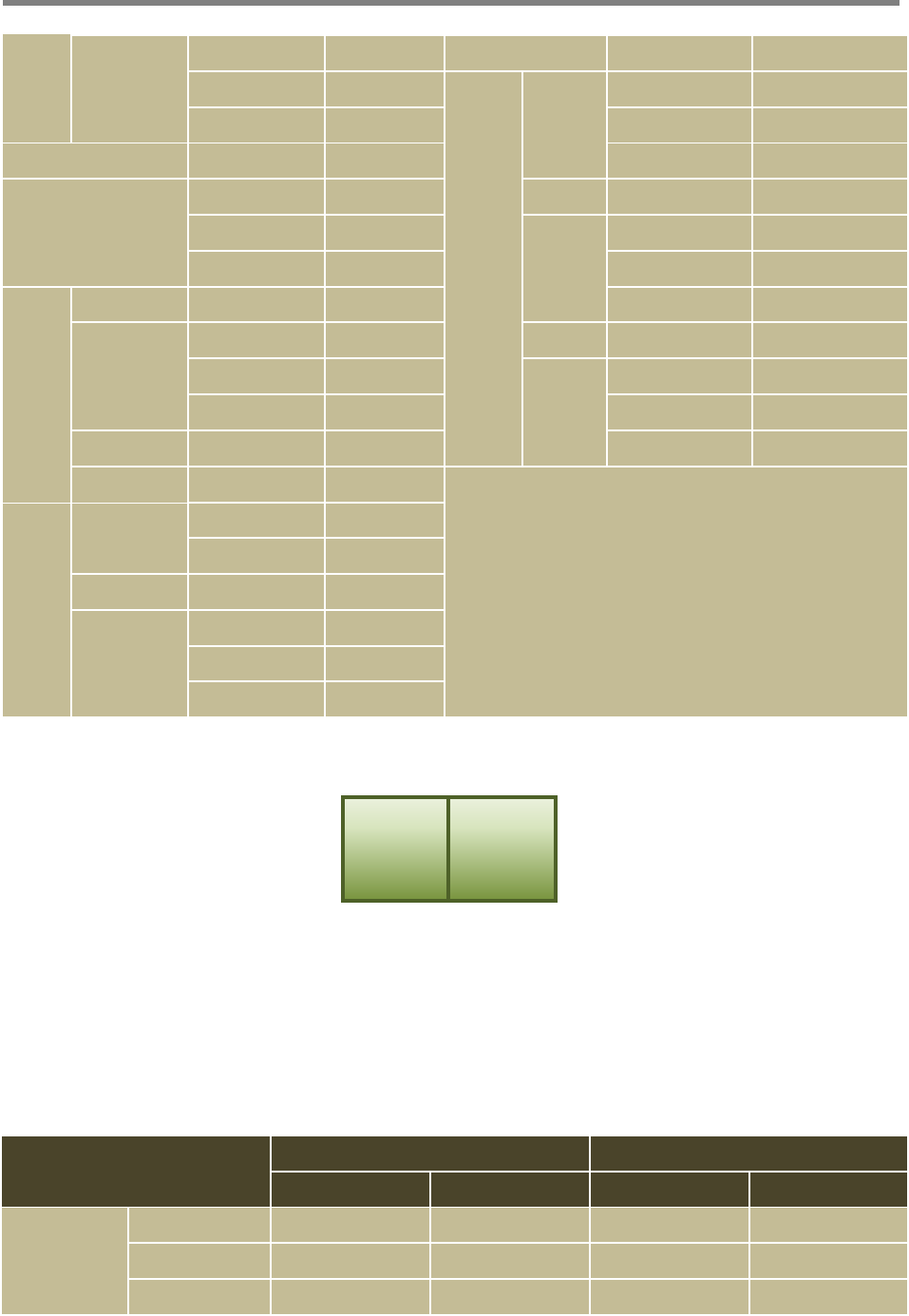
Verizon User Manual
Smart-Cell Repeater
13
A3
1941.25
225
guard
1975
900
1942.5
250
C
C1
1976.25
925
1943.75
275
1977.5
950
guard
1945
300
1978.75
975
D
1946.25
325
guard
1980
1000
1947.5
350
C2
1981.25
1025
1948.75
375
1982.5
1050
guard
1950
400
1983.75
1075
B
B1
1951.25
425
guard
1985
1100
1952.5
450
C3
1986.25
1125
1953.75
475
1987.5
1150
guard
1955
500
1988.75
1175
B2
1956.25
525
1957.5
550
1958.75
575
guard
1960
600
B3
1961.25
625
1962.5
650
1963.75
675
2.3.7. 2100MHz Frequency Selection
<Figure 7> 2100MHz Band Frequency
2100 Amp Unit has basically satisfies the CDMA standard, and supports non-contiguous
2 block. If you select “contiguous button”, Web UI has select the contiguous F band.
And you don’t select “Contiguous button”, Web UI has select the each band of F1 and
F2. Frequency range of each band as follows.
BAND
Downlink
Uplink
Start
Stop
Start
Stop
F
F1
2145.15
2149.85
1745.15
1749.85
guard
-
-
-
-
F2
2150.15
2154.85
1750.15
1754.85
F1
F2
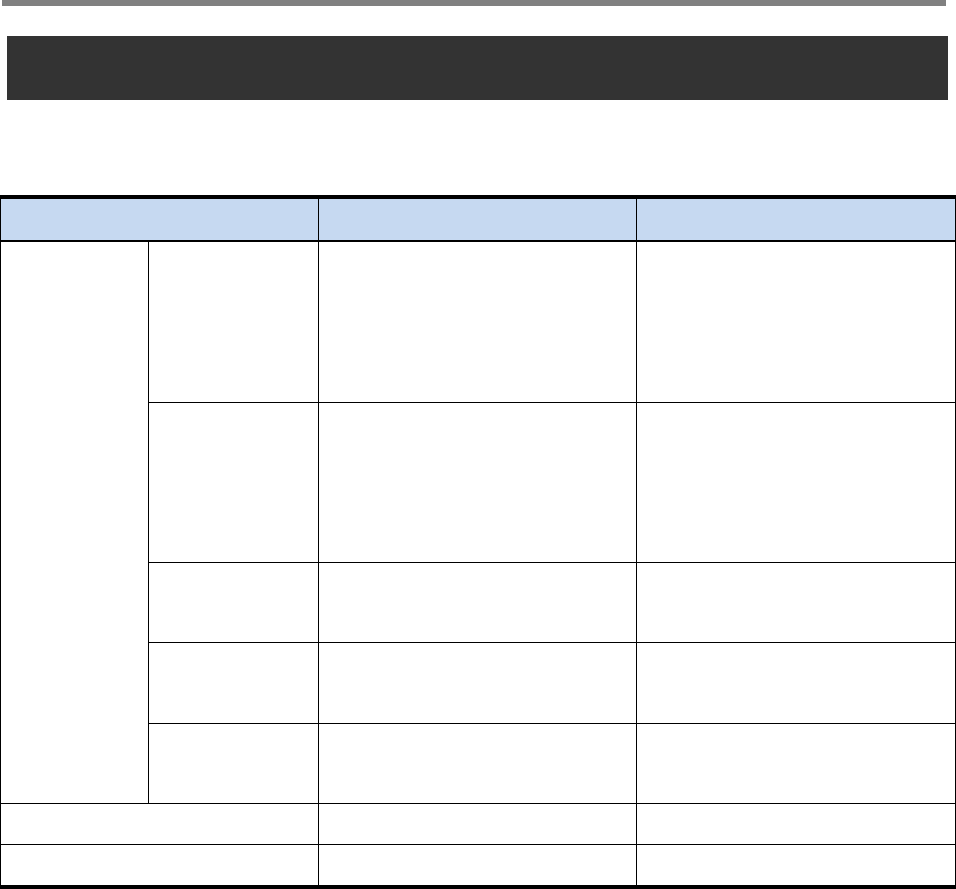
Verizon User Manual
Smart-Cell Repeater
14
3. SYSTEM SPECIFICATIONS
3.1. RF Performance
Item
Specification
Remark
Frequency
700MHz
DL : 728.5MHz ~ 739.5MHz
746MHz ~ 756MHz
UL : 698.5MHz ~ 709.5MHz
777MHz ~ 787MHz
10MHz + 10MHz
800MHz
DL : 862MHz ~ 863.8MHz
864MHz ~ 868.6MHz
UL : 817MHz ~ 818.8MHz
819MHz ~ 823.6MHz
1.8MHz + 4.8MHz
850MHz
DL : 869MHz ~ 894MHz
UL : 824MHz ~ 849MHz
25MHz
1900MHz
DL : 1930MHz ~ 1990MHz
UL : 1850MHz ~ 1910MHz
60MHz
2100MHz
DL : 2145MHz ~ 2155MHz
UL : 1745MHz ~ 1755MHz
10MHz
Maximum Input Power
-27dBm
Output Power (ANT Port)
+33dBm / 2W Total
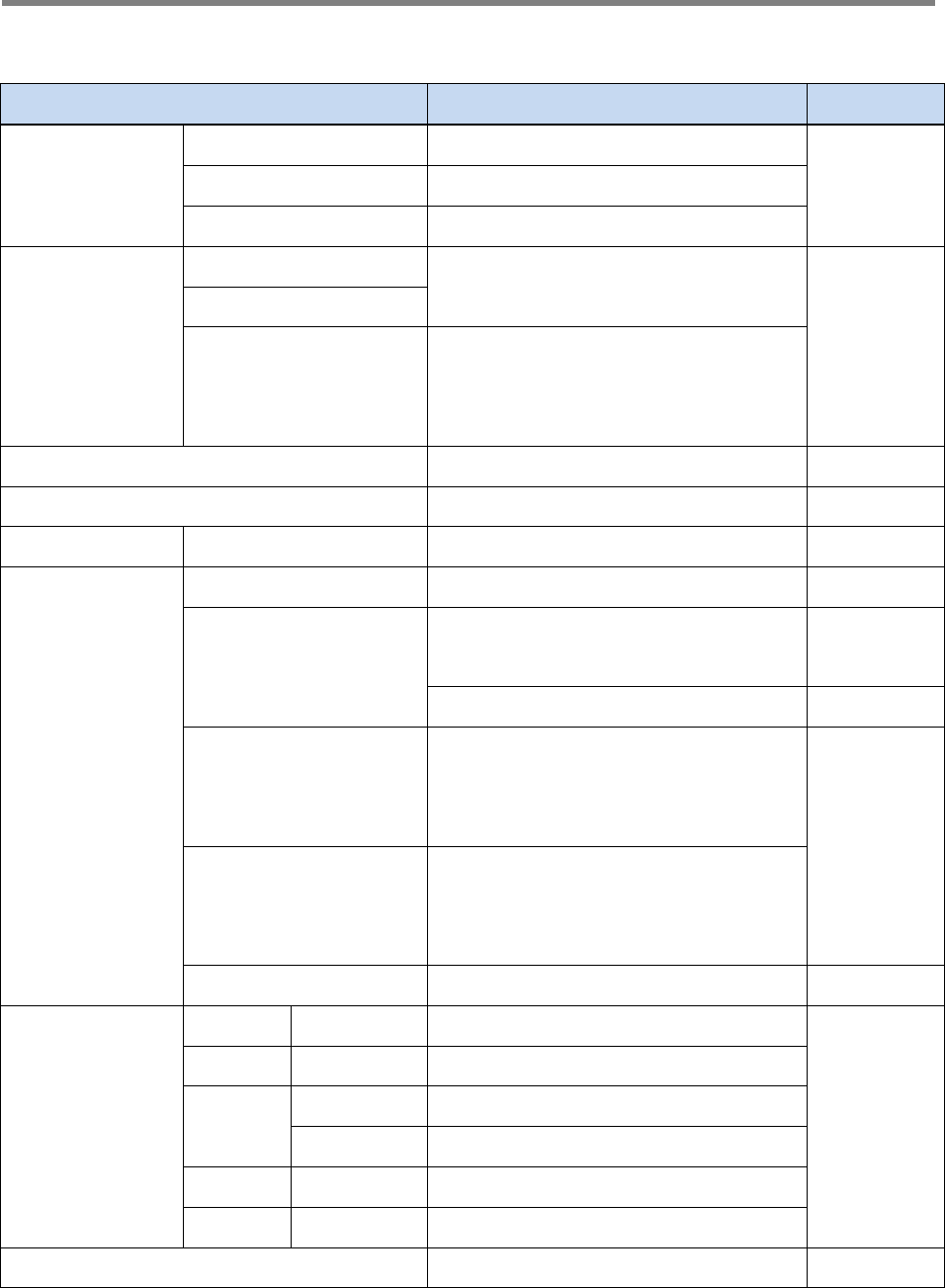
Verizon User Manual
Smart-Cell Repeater
15
3.2. System Specifications
Parameter
Specification
Remark
Gain
Range
60dB ~ 90dB
Adjust Step
±0.5dB
Adjust Accuracy
±1dB
Flatness
700MHz
< 3.0dBp-p
800MHz
850MHz
1900MHz
2100MHz
< 5.0dBp-p
Propagation Delay
≤ 6us
VSWR
1.7 : 1
Noise Figure
Max Gain
< 7dB
ACP
750MHz
45dBc @±5MHz/10MHz
800MHz
> 45 dBc ±750KHz
>50dBc@±1.98KHz
CDMA
45dBc @±5MHz/10MHz
LTE
850MHz
> 45 dBc ±885KHz
>52dBc@±1.98KHz
<-13dBm@Fc±2.25MHz (RBW: 1MHz)
1900MHz
> 45 dBc ±750KHz
>52dBc@±1.98KHz
<-13dBm@Fc±2.25MHz (RBW: 1MHz)
2100MHz
45dBc @±5MHz/10MHz
Roll off
700MHz
±1MHz
> 45dBc
800MHz
±1MHz
> 45dBc
850MHz
±1MHz
> 45dBc
±250kHz
> 30dBc
1900MHz
±1MHz
> 50dBc
2100MHz
±1MHz
> 40dBc
Characteristic Impedance
50Ω
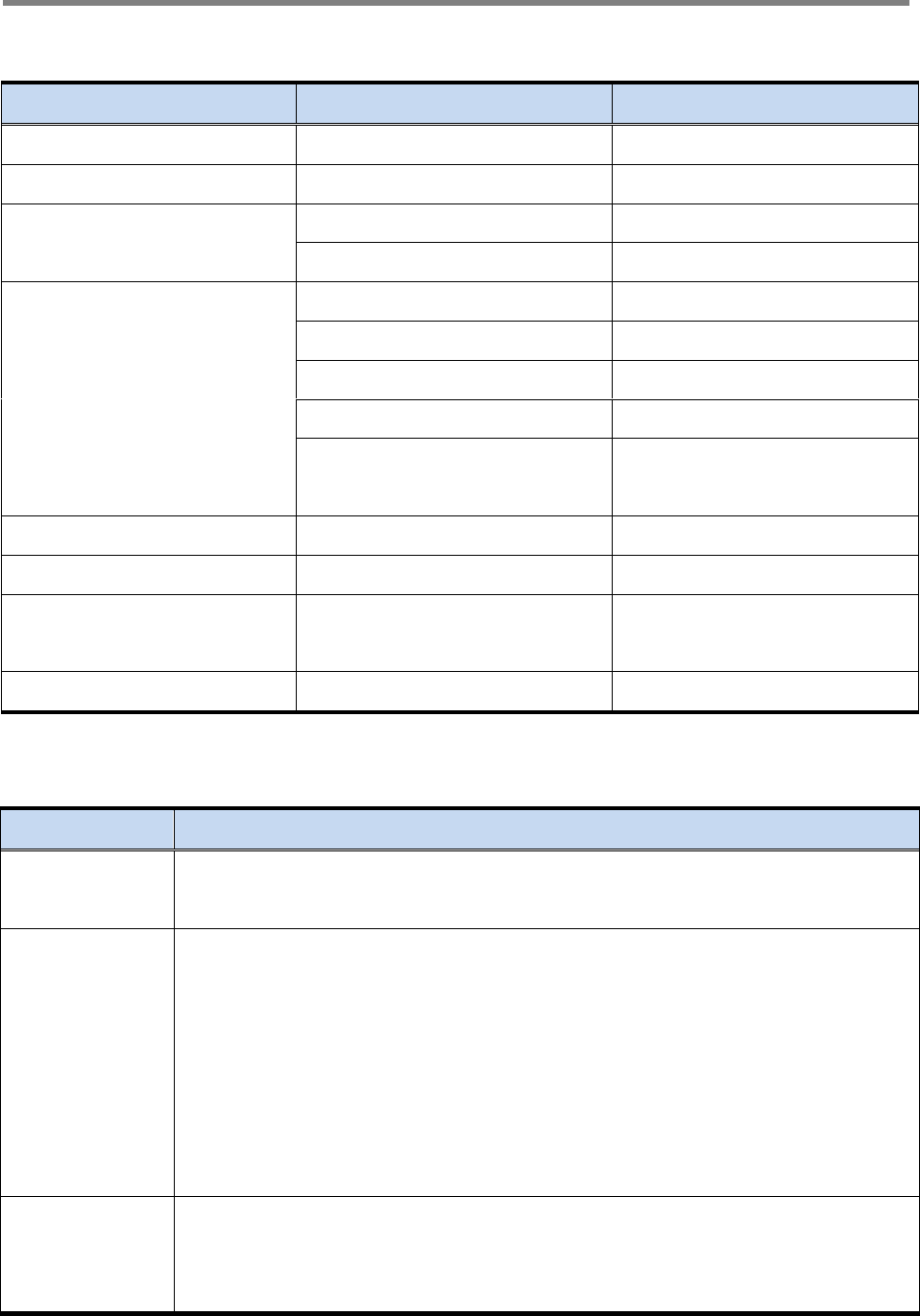
Verizon User Manual
Smart-Cell Repeater
16
3.3. Electrical and Environmental Specifications
Item
Specification
Remark
RF Connector
N-Type Female
Donor & Server ANT Port
AC Supply
AC 110V 60Hz 3.0A
Out Dimension
3.1” x 15.5” x 7.7”
AMP unit
19” x 19” x 7.9”
System (Rack mount)
Weight
13lbs
700 unit
11.5lbs
850 unit
11.5lbs
1900 unit
10lbs
2100 unit
23
19” rack + NMS + PSU
(except AMP units and FEU)
Operation Temperature
-10℃ ~ +50℃
Convection cooling
Humidity
5% ~ 95%
Non-condensing
Vibration Resistance
1G, 10~150Hz
0.1 Octaves/min
MTBF
50,000 hours
3.4. Functions
Parameter
Specification
Gain Control
• Adjustable DL and UL Gain range 60dB ~ 90dB.
• Display default Gain and current Gain function
ALC
Auto Limit
Control
• To limit output powers as far as default range.
• Used for DAS configuration and when oscillation/isolation is a concern.
• Automatic Gain decrement when output power of repeater is higher than
default level.
• Automatic Gain recovery when output power of repeater is reduced.
• Shutdown when output power is higher than default level in the minimum gain.
• Automatic Recovery Algorithm conversion after shutdown status.
Band Select
• 700MHz : Lower A(5MHz)/Lower B(5MHz)/Upper C(10MHz)
• 850MHz : A1(11MHz)/B1(10MHz)/A2(1.5MHz)/B2(2.5MHz)
• 1900MHz : 1.25MHz ~ 20MHz/1.25MHz step
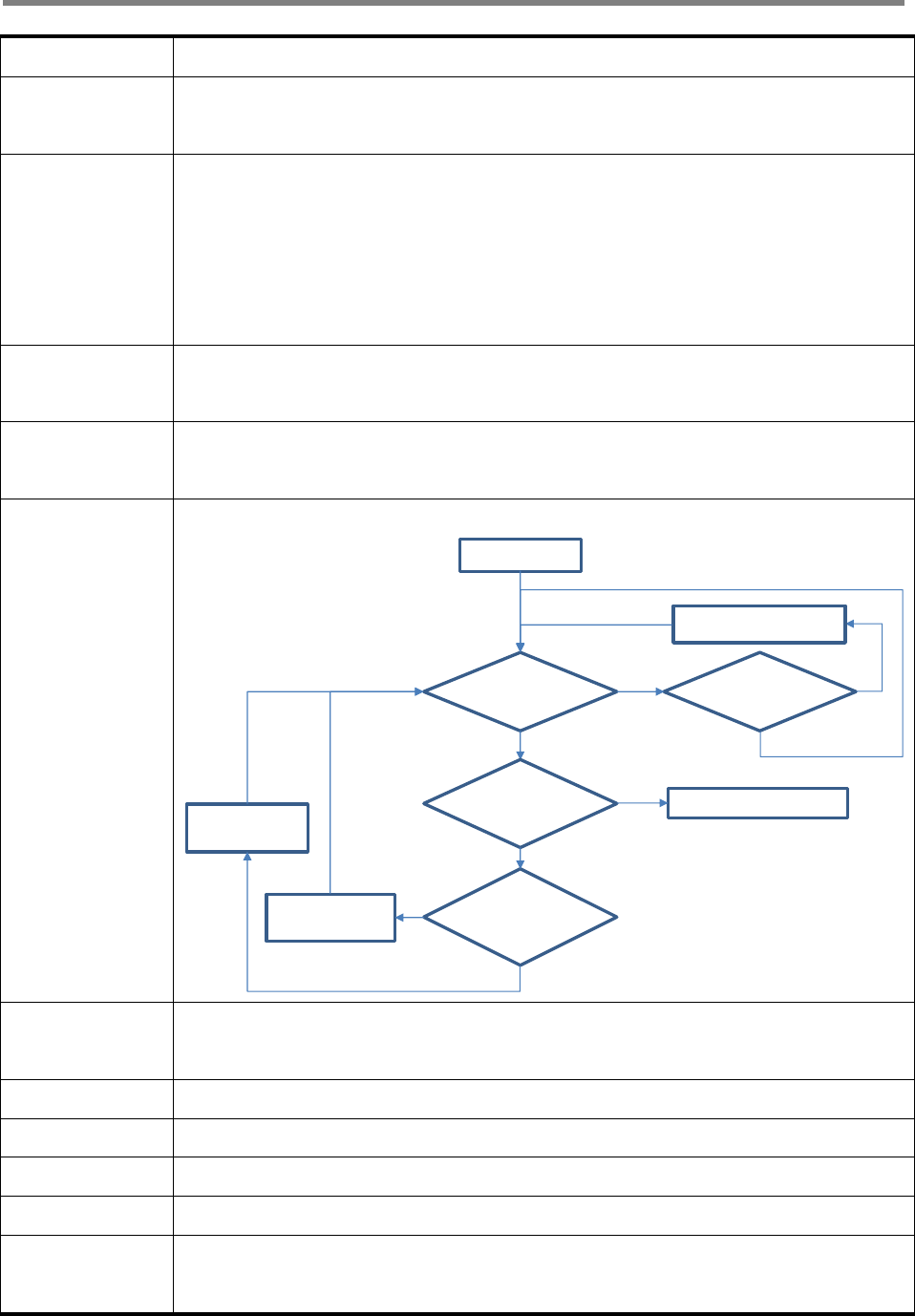
Verizon User Manual
Smart-Cell Repeater
17
• 2100MHz: 5MHz/10MHz
Power
Monitoring
• Monitoring repeater’s output level.
Oscillation Check
• Isolation Check in initial set up or Reset.
• When Oscillation occurred, repeater attempts to stabilize Isolation through Gain
control function.
• Shutdown repeater when oscillation still occurs in the minimum Gain.
• Automatic Recovery Algorithm conversion after shutdown status.
Automatic
Recovery
• When repeater is shutdown, it periodically recovers output power of repeater
then monitors alarming.
Security
• Support HTTPS for Web Browser security.
• User authentication through User ID and Password.
AOC
Auto Oscillation
Check Function
• AOC Use for prevented oscillation
VSWR
Monitoring
• Monitoring VSWR of Service ANT Port.
• Reporting VSWR Alarm and Shutdown when the rate is 3:1.
DHCP Client
• Automatic IP assignment.
DHCP Server
• Server function for automatic IP assignment.
Web GUI
• Remote and local user browser support through Web Browser.
SNMP Agent
• NMS report via SNMPv2 Trap.
LED Display
• LED displays power and operation status on front side of repeater system.
• Input and Output signal levels are verified by LED bars.
AOC on
Isolation Detect
< Isolation Limit
ALC Attenuation
+5dB
Isolation Detect
< Isolation Limit-4
ALC Attenuation
+1dB
No
Yes
ALC Attenuation
≥30dB Shutdown
Yes
Yes
No
Isolation Detect
> Isolation Limit-3
ALC Attenuation-1dB
Yes
No
No
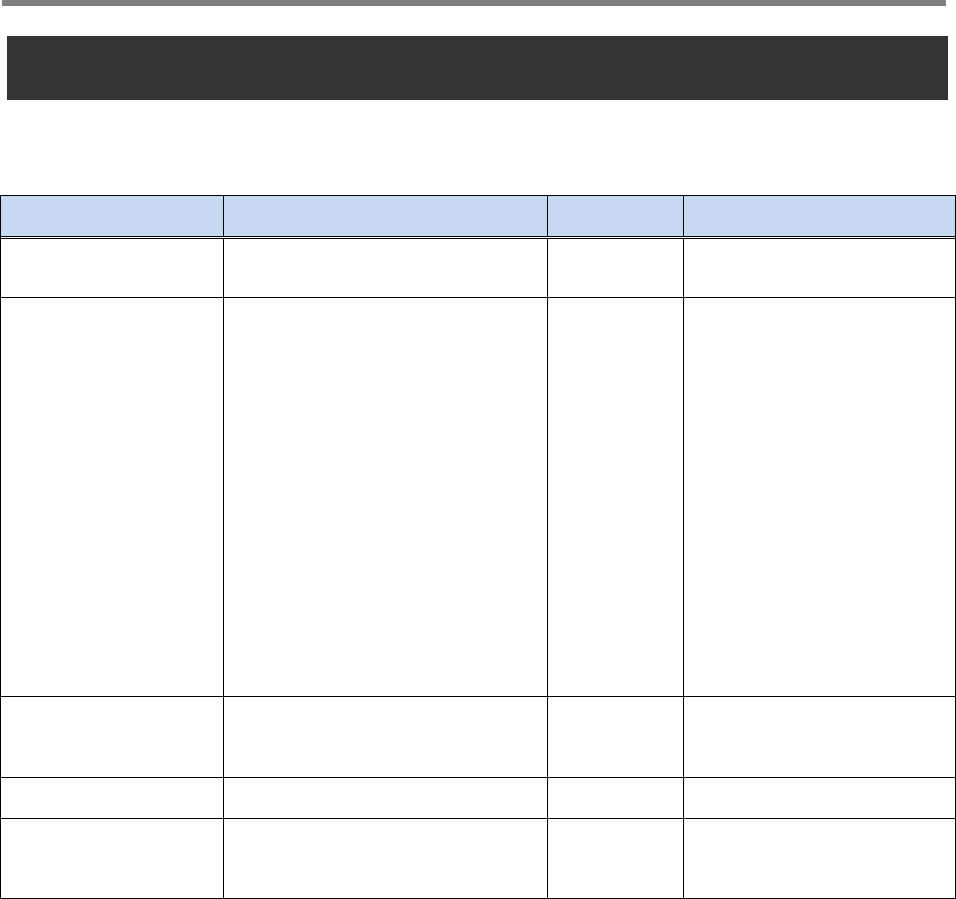
Verizon User Manual
Smart-Cell Repeater
18
4. SETUP
4.1. Equipment Needed for Repeater Setup
Parameter
Item
Quantity
Remark
Major Component
Smart-Cell Repeater
1 EA
Provided by GST
Additional
Components
WALL Mounting Bracket
CD which contains User Manual
V.1.0 and Installation Guide V.1.0
Ethernet Cable 6.6ft (2m)
Ground Cable 6.6ft (2m)
Ground Sems Screw M4 x 8mm
Bracket Sems Screw M6 x 10mm
Lag Screw 12.7mm x 50.8mm
FEU-AMP unit cable
FEU-Wall Bracket cable
1 EA
1 EA
1 EA
1 EA
4 EA
4 EA
4 EA
8 EA
2 EA
Provided by GST
Antenna
Donor ANT
Server ANT
1 EA
1 EA
Not Included
RF Cable
Antenna connection Cable
TBD
Not Included
Testing and
Measuring Equipment
Spectrum Analyzer
1 EA
Not Included
4.1.1. Check points before turning on the Repeater
1) System Power Check
① AC electrical power to the repeater should be 110V, input electricity only after
power verification.
2) Input RF Signal Range
① Optimal input RSSI into the repeater is -57dBm ~ -27dBm for
700MHz/850MHz/1900MHz/2100MHz. User should verify input condition of
Donor ANT. If the input RSSI exceeds -27dBm, then external attenuators should
be used.

Verizon User Manual
Smart-Cell Repeater
19
3) Isolation check between DONOR/SERVEICE ANT
① Isolation condition of this equipment is 105dBc (Gain+15dB). User should check
its condition before installation.
4.1.2. Open for Service
1) Check points before open:
① Verification of system installation status :
Electricity, In/Out antennas, cable connection, and equipment mount status.
② Verification of system accessories :
User should check all necessary accessories.
③ Check receipt signal level :
Installer should check whether environmental conditions are in accordance
with system specification to ensure that system operation will be optimized.
2) Check points after open:
① Check external LED
RUN: Green light ON (Off: all lights off)
ALARM: Green light in normal status, Red light in alarming
SHUT DOWN: Green light in normal status, Red light in Shutdown status
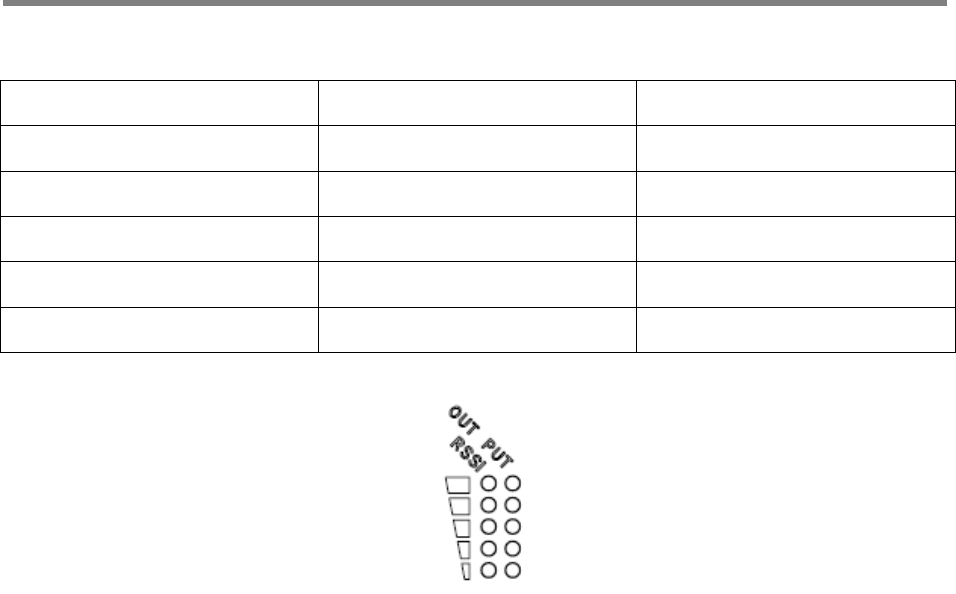
Verizon User Manual
Smart-Cell Repeater
20
4.1.3. Signal Strength LED Check
Number of LED bars
Input Signal Level
Output Power Signal Level
LED 1 bar
Less than -86dBm
Less than +5dBm
LED 2 bars
-85dBm ~ -79dBm
+6dBm ~ +10dBm
LED 3 bars
-78dBm ~ -72dBm
+11dBm ~ +15dBm
LED 4 bars
-71dBm ~ -65dBm
+16dBm ~ +20dBm
LED 5 bars
More than -64dBm
More than +21dBm
<Figure 9> Modular Repeater Front LED

Verizon User Manual
Smart-Cell Repeater
21
4.2. Setting up the Repeater
4.2.1. Quick GUI/Configuration
Use the following steps to commission the Repeater after all the cabling and antennas
are fixed in place and the Repeater is supplied with proper electrical power. The
repeater will need a good quality stable Downlink RSSI input level in the range of -
85dBm to -60dBm.
1) Connect your laptop to the repeater with a Crossover Ethernet cable.
2) Verify that your laptop has all wireless connections off and is Obtaining an IP address
automatically, or is using a proper fixed IP address such as: Use the following IP
address: 172.16.6.81 with a Subnet Mask of 255.255.255.252.
3) Open Internet Explorer and go to: 172.16.6.81
4) User name: admin
5) Password: admin
4.2.2. Quick Setup
1) Go to the RF Configuration page.
2) Before the Amplifier (HPA) can be turned on, set the Uplink and Downlink
attenuation (ATT) to the maximum value and click Apply.
3) Select the correct Band Block and set the ALC Downlink and Uplink Limits to the
desired level and click Apply. (To adjust the Output Power, change the ALC
Downlink and Uplink Limits to the desired levels).
4) To check the Repeater’s status, click on the Status page.
5) To change the Repeater’s gain/attenuation, adjust the Uplink and Downlink
attenuation in equal amounts not more than 5dB at a time and click Apply.

Verizon User Manual
Smart-Cell Repeater
22
4.3. Web UI Ranges Table
GUI Feature
Range
Description
Downlink and Uplink Output
Power Display
Below 0dBm to
35dBm
The output Power of the Repeater
Downlink Low RF Power
2dB to 10dB
Threshold for Low RF Power
Downlink and Uplink
Attenuation Control
0dB to 30dB
Reduces Gain Internally
Downlink and Uplink ALC
Limit
0dBm to 33dBm
Limits Output Power
Downlink RSSI Display
-100dBm to -27dBm
Downlink Receive Level at Donor
Antenna Port
Downlink Low RSSI
-93dBm to -57dBm
Threshold for Low RSSI
Downlink and Uplink AMP
Control
On/Off
High Powered Amplifier
Gain Balance Control
On/Off
Equalizes Uplink and Downlink Gain
Gain Balance Value
0dB to 15dB
Subtract Uplink Gain by G/B Value
Shutdown Control
On/Off
Shutdown if Major Alarm is Reported
Auto Gain Setting
On/Off
Automatic Gain Setting for the
Repeater
Auto Oscillation Check
On/Off
Preventing Oscillation
Temperature Display
32 to 260.6 Degrees
Internal Repeater Temperature
AMP Temperature Upper
Limit
0 to 299 Degrees
Threshold for Temperature Alarm
Band Blocks Used/Bandwidth
Each AMP
The Channel the Repeater will be
using
Delay Alarm Report
0 or 5 Minutes
Time Delay of Reporting after Alarm is
Detected

Verizon User Manual
Smart-Cell Repeater
23
4.4. Troubleshooting
In case of abnormal operation, technician should diagnose abnormality via remote
access or directly connecting to repeater using Ethernet cable. If technician is required
to conduct repairs due to major alarm, repeater should first be powered off, and then
technician should prepare the proper measurement equipment before trying to fix the
problem. In most cases of major repairs, GST will simply replace the unit and conduct
repairs at the appropriate facility.
4.4.1. Simple Troubleshooting Method
1) Verify LED Status, both on external LED’s as well as internal module LED’s
- Normal operation: Green light on. Alarming: Red LED on.
2) Technician should check external and internal connectors to ensure that all
connections are tightly secure. These connectors should be cleaned regularly.
3) If technician thinks there is a serious problem, call after sales team for over-the-
phone technical support. 1-866-9-GST-USA (1-866-947-8872)
4.4.2. Alarm Information
Alarm
Name
What causes this
alarm
Troubleshooting Methods
Downlink
Spurious
emissions
out of spec
Downlink Output
Power exceeds
Downlink Upper Limit
* The Downlink Output Power should not exceed the
maximum composite power spec for this unit.
* If the Downlink Output Power is not exceeding the
composite power spec for this unit, try to increase
the Downlink Upper Limit on the RF Configuration
Page.
* Add equal amounts of Uplink and Downlink
attenuation until the Downlink Output Power is less
than the Downlink Upper Limit.
* Set the ALC Downlink Limit on the RF Configuration
Page to a value lower than the Downlink Upper Limit

Verizon User Manual
Smart-Cell Repeater
24
Downlink
Hardware
failure
Downlink path gain is
6dB less than RSSI
plus Output Power
* By default, if the Downlink Low Output Variance is
set to 10dB, the Repeater will not report this alarm.
* Increase the Downlink Low Output Variance on the
RF Configuration Page.
Downlink
Donor
power too
low
Input RSSI from
Donor site is 8dB less
than Downlink Low
Input Limit
* By default, if the RSSI Lower Limit is set to -93dBm,
the Repeater will not report this alarm.
* Decrease the Downlink Low RSSI Limit level on the
RF Configuration Page.
* Increase the RSSI level into the Repeater.
Downlink
VSWR
When the VSWR
Ratio on the Server
Port is greater than
3 : 1
* "Sweep the line" to check for loose or damaged
connectors and/or cabling.
* If after checking the entire Server side, the VSWR
alarm still exists and the system is working fine,
Disable the alarm on the Alarm Configuration page.
Downlink
Donor
power too
high
Downlink Input
Power exceeds -
25dBm
* Check the direction of donor antenna
* Even if higher input power after the modifying
direction of donor antenna, Be adding an attenuator
at the Donor port.
Downlink
Synthesizer
failure
Synthesizer (in
Downlink path) has
occur Failure
* By using a switch on the back of the repeater,
resets the power
* Call to GST’s Tech Support Team and exchange the
AMP unit.
Downlink
Interfere
power
exceeded
If an external signal is
higher than the in
band signal, more
than 15dB signal
* Call the GST’s Tech Team, resolved in accordance
with the procedure.
Uplink Out
of band
emissions
out of spec
Uplink Output Power
exceeds Uplink Upper
Limit
* The Uplink Output Power should not exceed the
maximum composite power spec for this unit.
* If the Uplink Output Power is not exceeding the
composite power spec for this unit, try to increase

Verizon User Manual
Smart-Cell Repeater
25
the Uplink Upper Limit on the RF Configuration Page.
* Add equal amounts of Uplink and Downlink
attenuation until the Uplink Output Power is less
than the Uplink Upper Limit.
* Set the ALC Uplink Limit on the RF Configuration
Page to a value lower than the Uplink Upper Limit
Uplink
Power at
coverage
port too
high
Uplink Input Power is
higher than -25dBm
* Check the direction of Coverage antenna
* When another device is connected to the Coverage
port as DAS System
1) Add an attenuator on Coverage port, or
2) Uplink to adjust the output of the additional
equipment.
Uplink
Synthesizer
failure
(Uplink
Hardware
failure)
Synthesizer (in uplink
path) has occur
Failure
* By using a switch on the back of the repeater,
resets the power
* Call to GST’s Tech Support Team and exchange the
AMP unit.
Uplink
(Downlink)
Software
failure
When an alarm
occurs in DFM's at
the AMP unit.
* By using a switch on the back of the repeater,
resets the power
* Call to GST’s Tech Support Team and exchange the
AMP unit.
Oscillation
detected/Lo
w isolation
Insufficient isolation
is detected when the
Repeater is at
minimum gain
* Verify that the Donor antenna is on the same side
of the building as the Donor site, and if needed, raise
the Donor antenna up on a pole.
* Change the types of antennas used, such as Yagi to
Corner-Reflector for outdoors, and Omni to a Panel
for indoor use.
* Move the closest indoor service antenna farther
away from the outside Donor antenna.

Verizon User Manual
Smart-Cell Repeater
26
* Close the repeater door if opened and verify that
the closest indoor coverage antenna is not in the
same room as the repeater.
Field
Replaceable
module
failure
Filter service has not
matches between
Amp Unit and DFM
* Call to GST's Tech Support Team to verify that all
the settings are correct.
Tamper
Detected
When mount
information (in the
system ) is changed
* After 5 minutes clear automatically.
* If you want to disable, you can on the Alarm
Configuration page.
Communicat
ion Failure
If the communication
between the NMS
Board and Amp Unit
would not operating
normally
* SNMP board or AMP unit need to reset.
* Open the rear cover and check the each cable.
Power
Supply out
of range
The internal Power
Supply detects
improper Voltage
* If the system is working fine, disable the alarm on
the Alarm Configuration page.
* Call to GST's Tech Support Team to verify that all
the settings are correct.
Over
Temperature
Internal AMP
temperature exceeds
the Temperature
Limit
* Verify that the Temperature Limit is set between
176 °F ~ 201 °F on the RF Configuration page.
(Default Value is 163°F)
Reset alarm
When the unit has
reset
* After 30 seconds clear automatically.
Manual
Shutdown
When the operates
shutdown algorithm,
after re-check
* By using a switch on the back of the repeater,
resets the power
* Reset the AMP unit, By Web UI.
FAN
in the event of a fan
failure
* Replace the fan

Verizon User Manual
Smart-Cell Repeater
27
4.4.3. Troubleshooting Guide Related to RF
Item
Check Point
Troubleshooting
Check before
system
operation
System input power
range
-Downlink: -100dBm ~ -27dBm
-Uplink: -100dBm ~ -27dBm
System gain
(DL/UL)
- 60dB ~ 90dB
Output power
at server port
- Downlink: 33dBm ± 2dB
- Uplink: 33dBm ± 2dB
Check points before
open for service
-Please check quantity of all accessories with
specification before you set up
-Fit cable length in accordance with field
condition
Check after
system
operation
Check points after open
for service
Check following status;
-Verify that the antennas are securely mounted
and pointed in the correct directions
-Connection status between antennas and RF
cable
-Verify that the Repeater is securely mounted
-Proper AC power status
-Grounding status of electrical circuit
-Coaxial cable (RF) construction status
-Connectors and combiners connection status
-Cable connection status against leakage of
water
When
repeater
does not
work
properly
Check electricity cord
connection status
-Re-plug in Adapter cord

Verizon User Manual
Smart-Cell Repeater
28
When in
alarming
DL VSWR alarm
Please Check following status;
-Make sure Server Antenna Port is disconnected.
-Please reset Adapter upon completing Alarm
troubleshooting
DL over-output alarm
-Make sure output power is operating normally
-Please Reset Adapter upon completing Alarm
troubleshooting
UL over-output alarm
-Please make sure output level is operating
normally
-Please reset Adapter upon completing Alarm
troubleshooting
Temperature alarm
Check following status;
-Setting level of maximum temperature limit
-Temperature offset is normal or not
-Circumstances of temperature
-Please Reset Adapter upon completing Alarm
troubleshooting
RF off
-Verify that the HPA’s are On
-Please Reset Adapter upon completing Alarm
troubleshooting
When output
power is no
longer
problem
Technician should verify
category of alarm at the
front side of repeater
-When Red light on the Shutdown LED, technician
should troubleshoot the alarm via Notebook
computer
-Technician should
connect antenna with
output port of repeater
-Please make sure all
connectors are fastened
-Reconnect the connector
-Change it if the connector is defective
Check the input level
-Increase output power or check input change of
BTS side

Verizon User Manual
Smart-Cell Repeater
29
Check gain of the unit
-If the Gain is different from normal level, please
contact A/S team
Cable connector loose
-It is possible for connectors to get too tight and
damage the equipment or throughput
-Please contact installer or service provider upon
verification
In case of
dropped call
or bad signal
after set up
Check input signal
strength in the service
area
-Increase output power level of repeater by
adjusting attenuation level
If input signal strength
is not a problem, please
check delay of calling
time
-Increase output level of Uplink signal, then set to
optimal level.
Check RSSI signal
strength
-Contact network management team or service
provider
In case
output
Signal
wavelength
is not shown
flat or looks
like
oscillation
Check connection
fastened between
antenna and cable
(Signal wavelength
should be flat and
stable if technicians
shake CABLE. If not, it is
connection problem)
-If connection is not proper, reconnect cable and
connector and then check the output power again
Input level change or
module overheating
-Check input level from BTS side.
-Check performance of each module (Diagnosed
by A/S team)
Please check VSWR of
the cable is normal
-Change to normal Cable
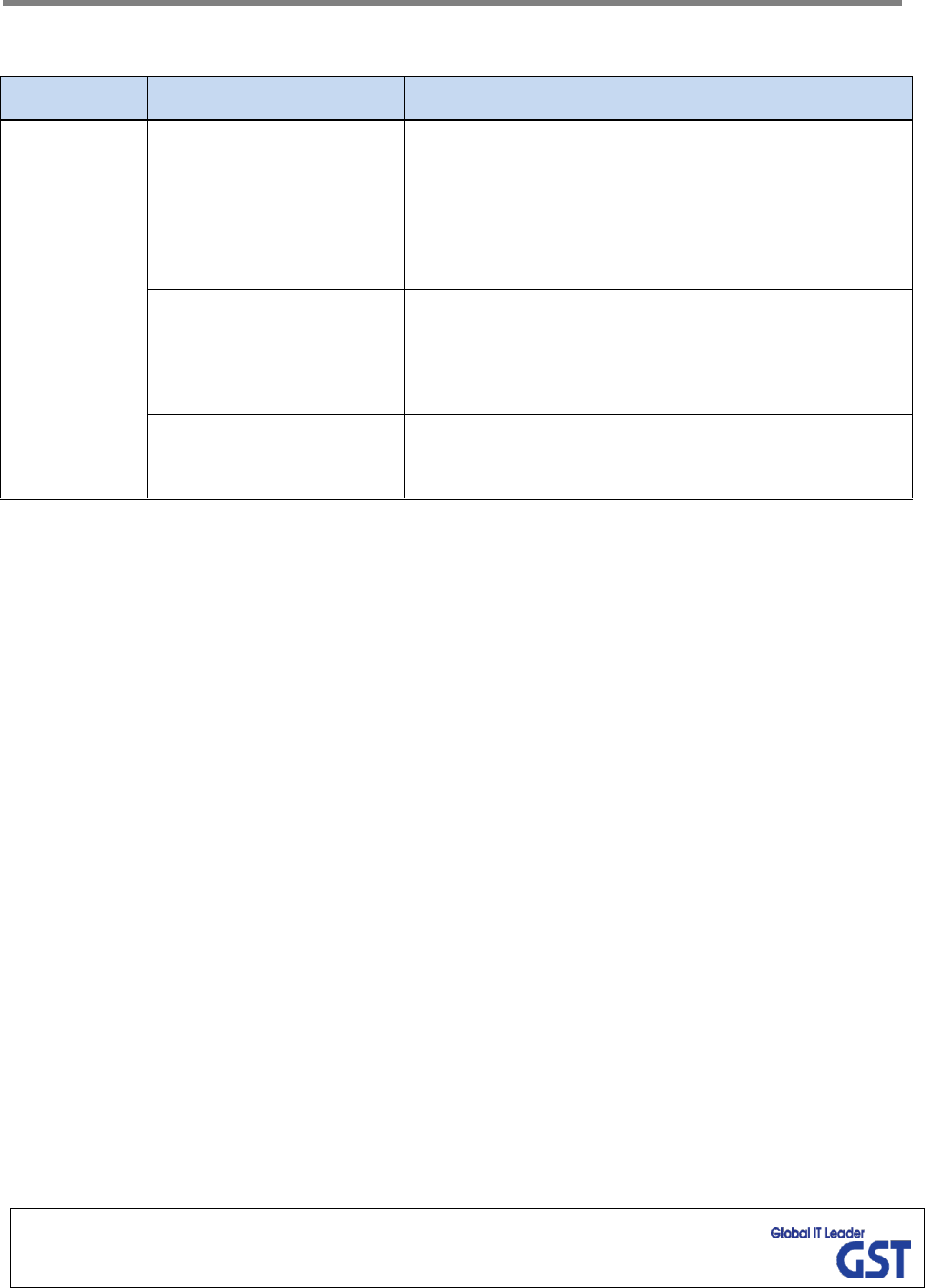
Verizon User Manual
Smart-Cell Repeater
30
4.4.4. Troubleshooting Guide Related to NMS
Symptom
Check Points
Troubleshooting
Link Fail
Communication
problem
-In case of Ethernet, verify IP addressing, DHCP
function, and that cookies are deleted
-Verify that a crossover Ethernet cable is being
used
CLI connection, cable
status check
-Make sure 1:1 connection
-Follow instructions in the installation guide for
this connection procedure
CLI connection Check by
USB to serial cable
-Please verify port number of PC communication
-Please check cable connection status
If technician thinks there is a serious problem, call after sales team for over-the-phone
Technical support. 1-866-9-GST-USA (1-866-947-8872).
6900 College Blvd. Suite 850
Overland Park, Kansas 66211
Tel: 913 469 6699
Fax: 913 661 0163
Email: support@gsteletechinc.com
Web: http//www.gsteletechinic.com
6900 College Blvd. Suite 850
Overland Park, Kansas 66211
Tel: 913 469 6699
Fax: 913 661 0163
Email: support@gsteletechinc.com
Web: http//www.gsteletechinic.com